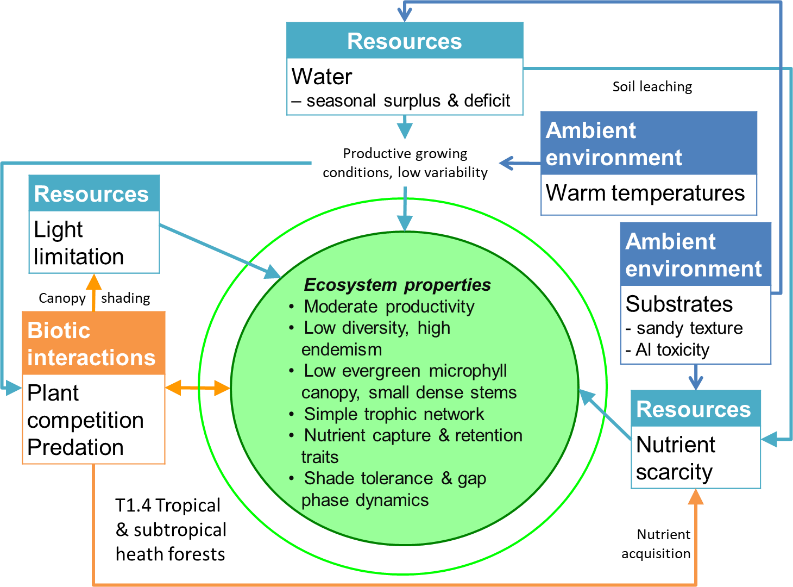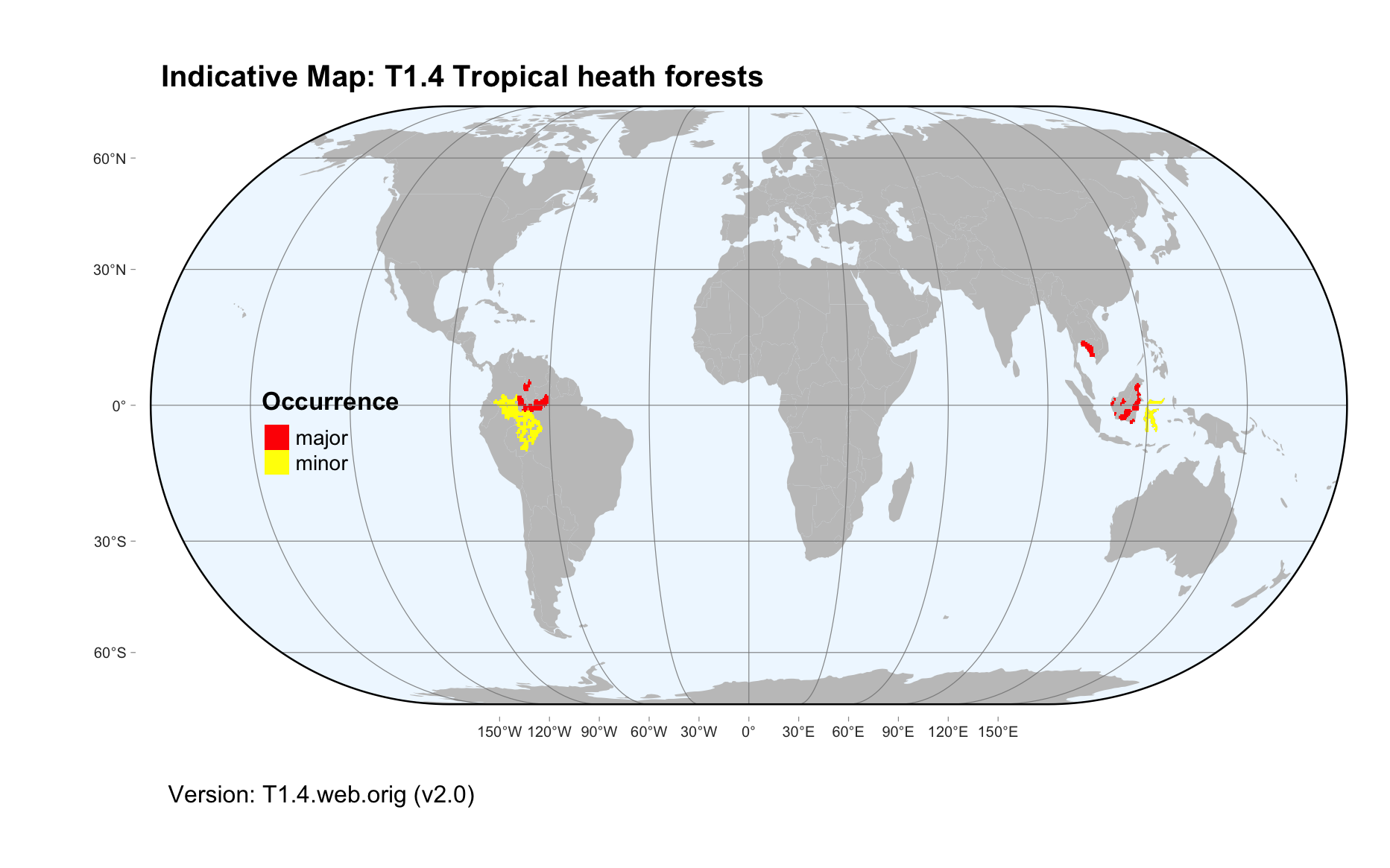Global ecosystem typology
Alternative site for the Global ecosystem typology with additional information for ecosystem profiles and indicative maps.
This site is maintained by jrfep
T1.4 Tropical heath forests
Biome: T1. Tropical-subtropical forests biome
Contributors:
(texts)
These structurally unique forests are restricted to less fertile soils on acidic sandy substrates best known in Amazonia and Southeast Asia. They are characterised by high densities of low, slender trees that allow light penetration to an open forest floor covered with mosses. They have low productivity compared to other tropical forests, with a limited diversity of plants and animals forming a simple foodweb, including amphibians and reptiles.
Key Features
Low closed-canopy evergreen forests in warm wet climates on low-nutrient substrates, structurally simple cf T1.
Overview of distribution
Amazon basin, southeast Asia, possibly Congo basin.
Profile versions
- v1.0 (2020-01-20): DA Keith; A Etter
- v2.0 (2020-07-03): DA Keith; RT Young; A Etter
- v2.01 ():
- v2.1 (2022-04-06): DA Keith; RT Young; A Etter Full profile available at official site
Main references
Selected references for this functional group:
Adeney JM, Christensen NL, Vicentini A, Cohn-Haft M (2016) White-sand ecosystems in Amazonia. Biotropica 48: 7–23. DOI:10.1111/btp.12293
Miyamoto K, Rahajoe JS, Kohyama T (2007) Forest structure and primary productivity in a Bornean heath forest. Biotropica 39: 35–42. DOI: 10.1111/j.1744-7429.2006.00231.x
Fortune C, Paine CET; Fine PVA, J. B. Kraft NJB, Baraloto C (2014) Environmental factors predict community functional composition in Amazonian forests. Journal of Ecology 102, 145-155. DOI:10.1111/1365-2745.12160
Ashton PS, Seidler R (2014) On the forests of tropical Asia: lest the memory fade Kew Publishing: Kew
Miyamoto K, Wagai R, Aiba S, Nilus R (2016) Variation in aboveground stand structure and fine-root biomass of Bornean heath (kerangas) forests in relation to altitude and soil nitrogen availability Trees-Structure and Function 30, 385-394
Diagrammatic assembly model

Maps
Maps are indicative of global distribution patterns are not intended to represent fine-scale patterns. The maps show areas of the world containing major (coloured red) or minor occurrences (coloured yellow) of each ecosystem functional group. See general notes on maps.
There are 2 alternative versions of the indicative map for this functional group, please compare description and sources below.
T1.4.IM.orig_v2.0
Datasets
- Resolve-Ecoregions-2017
Map references
Dinerstein E, Olson D, Joshi A, Vynne C, Burgess ND, Wikramanayake E, Hahn N, Palminteri S, Hedao P, Noss R, Hansen M, Locke H, Ellis EE, Jones B, Barber CV, Hayes R, Kormos C, Martin V, Crist E, Sechrest W, Price L, Baillie JEM, Weeden D, Suckling K, Davis C, Sizer N, Moore R, Thau D, Birch T, Potapov P, Turubanova S, Tyukavina A, de Souza N, Pintea L, Brito JC, Llewellyn Barnekow Lillesø JP, van Breugel P, Graudal L, Voge M, Al-Shammari KF, Saleem M (2017) An Ecoregion-Based Approach to Protecting Half the Terrestrial Realm, BioScience 67: 534–545. DOI:10.1093/biosci/bix014. Data-set available on-line
T1.4.web.orig_v2.0

Datasets
- Resolve-Ecoregions-2017
Map references
Dinerstein E, Olson D, Joshi A, Vynne C, Burgess ND, Wikramanayake E, Hahn N, Palminteri S, Hedao P, Noss R, Hansen M, Locke H, Ellis EE, Jones B, Barber CV, Hayes R, Kormos C, Martin V, Crist E, Sechrest W, Price L, Baillie JEM, Weeden D, Suckling K, Davis C, Sizer N, Moore R, Thau D, Birch T, Potapov P, Turubanova S, Tyukavina A, de Souza N, Pintea L, Brito JC, Llewellyn Barnekow Lillesø JP, van Breugel P, Graudal L, Voge M, Al-Shammari KF, Saleem M (2017) An Ecoregion-Based Approach to Protecting Half the Terrestrial Realm, BioScience 67: 534–545. DOI:10.1093/biosci/bix014. Data-set available on-line
Check: the Glossary / Profile structure / the public document